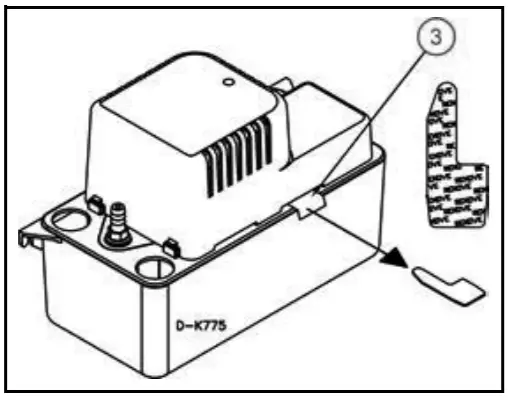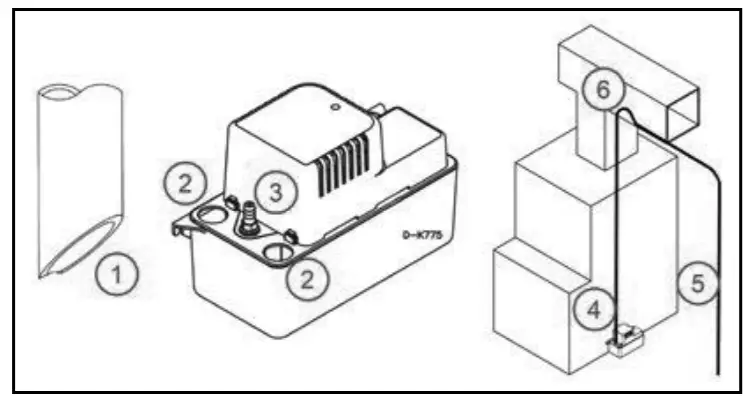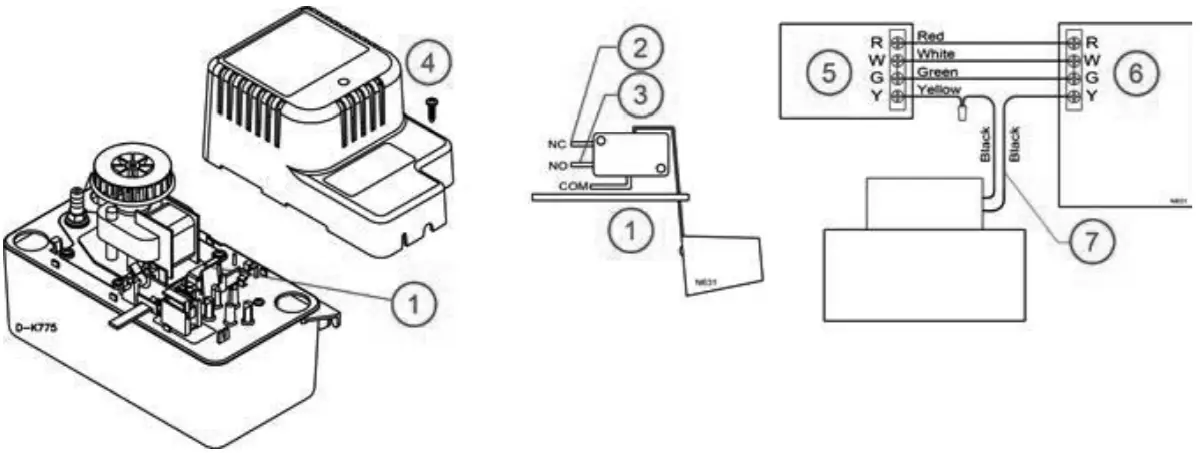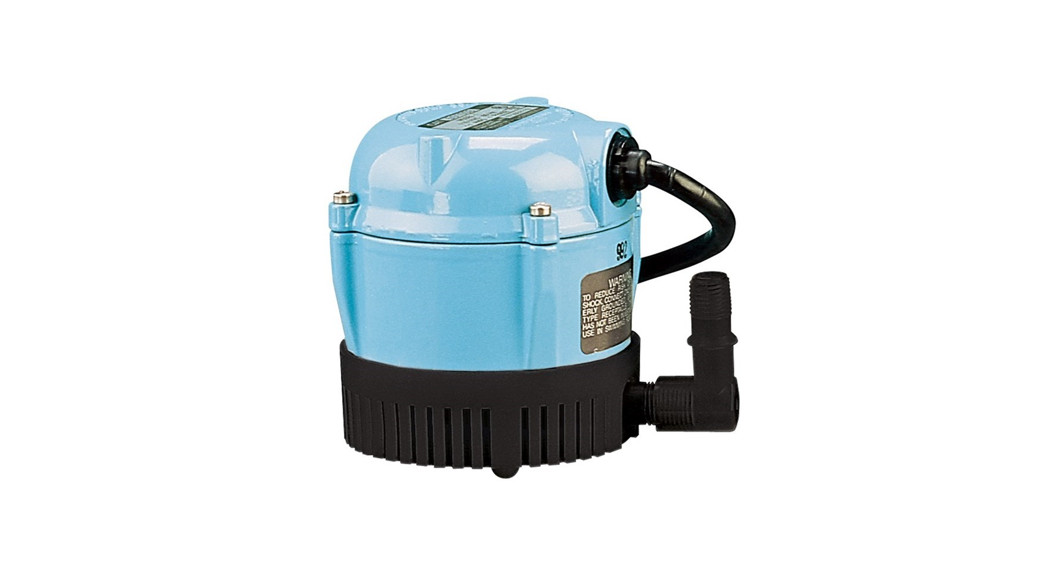
OWNER’S MANUAL
VCMA Condensate Pump Series
This pump automatically removes condensate water that drips from an air conditioner evaporator coil, refrigeration equipment coil, condensing furnace, or condensing boiler. The pump is controlled by a float switch mechanism, which automatically starts and stops the pump.Some models also include a high-water level switch, which opens a thermostat circuit when the pump reservoir is full, stopping the production of condensate. Alternatively, this switch can be reconfigured to close a circuit, which can operate an external alarm or relay, (purchased separately).This product is covered by a Limited Warranty for a period of 12 months from the date of original purchase by the consumer. For complete warranty information, refer to www.LittleGiant.com.

Specifications
| Model | Volts | HZ | Amps | Watts | Shut Off |
| VCMA-15 | 115 | 60 | 1.0 | 60 | 15’ (4.6 m) |
| VCMA-20 | 115 | 60 | 1.5 | 93 | 20’ (6.1 m) |
| VCMA-20 | 230 | 50/60 | 0.5 | 75 | 17’ (5.2 m) |
SAFETY INSTRUCTIONS
Before Getting Started
This equipment should be installed and serviced by technically qualified personnel who are familiar with the correct selection and use of appropriate tools, equipment, and procedures. Failure to comply with national and local electrical and plumbing codes and within Little Giant recommendations may result in electrical shock or fire hazard, unsatisfactory performance, or equipment failure.Know the product’s application, limitations, and potential hazards. Read and follow instructions carefully to avoid injury and property damage. Do not disassemble or repair the unit unless described in this manual.Failure to follow installation or operation procedures and all applicable codes may result in the following hazards:
![]()
![]()
![]()
![]()
- Do not use to pump flammable or explosive fluids such as gasoline, fuel oil, kerosene, etc.
- Do not use in explosive atmospheres or hazardous locations as classified by the NEC, ANSI/NFPA70.
- Do not handle a pump or pump motor with wet hands or when standing on a wet or damp surface, or in water.
- When a pump is in its application, do not touch the motor, pipes, or water until the unit is unplugged or electrically disconnected.
- If the power disconnect is out of sight, lock it in the open position and tag it to prevent the unexpected application of power.
![]()
![]()
![]()
![]()
![]()
![]()
![]()
- To reduce the risk of electrical shock, disconnect power before working on or around the system.
- Wire pump system for correct voltage.
- Be certain that this pump is connected to a circuit equipped with a ground fault circuit interrupter (GFCI) device if required by
- Check electrical outlets with a circuit analyzer to ensure power, neutral, and ground wires are properly connected.
- Some pumps are supplied with a grounding conductor and grounding-type attachment plug. To reduce the risk of electric shock, be certain that it is connected only to a properly grounded grounding-type receptacle. Do not remove the third prong from the plug. The third prong is to ground the pump to help prevent possible electric shock hazards.
- Some pumps are supplied with lead wires and are intended to be hardwired using a junction box or other approved enclosure. The pumps include a grounding connector. To reduce the risk of electric shock, be certain that it is properly connected to the ground.
- In a 230 V direct wire installation, one side of the line going to the pump is always electrically energized, regardless of whether the liquid level control switch is open or closed. To avoid hazards when installing or servicing, install a double-pole disconnect near the pump installation.
- The flexible jacketed cord assembly mounted to the pump must not be modified in any way, with the exception of shortening the cord to fit into a control panel. Any splice between the pump and the control panel must be made within a junction box and comply with the National Electrical Code.
- Check local electrical and building codes before installation. The installation must be in accordance with their regulations as well as the most recent National Electrical Code (NEC) and the Occupational Safety and Health Act (OSHA).
- Do not use the power cord for lifting the pump.
- Do not use an extension cord.
- The pump should only be used with liquids compatible with pump component materials. If the pump is used with liquids incompatible with the pump components, the liquid can cause failure to the electrical insulation system resulting in electrical shock.
![]()
![]()
![]()
![]()
![]()
![]()
![]()
- This equipment must not be used by children or persons with reduced physical, sensory or mental abilities, or lacking in experience and expertise, unless supervised or instructed. Children may not use the equipment, nor may they play with the unit or in the immediate vicinity.
- Equipment can start automatically. Lockout-Tagout before servicing equipment.
- An inoperative or malfunctioning pump could lead to flooding, resulting in personal injury or property damage.
- The operation of this equipment requires detailed installation and operation instructions provided in this manual. Read the entire manual before starting installation and operation. End-User should receive and retain the manual for future use.
NOTICE
Risk of damage to the pump or other equipment.
- Before installing the pump, allow the air conditioner to cycle several times, collecting condensate in a separate container to help flush any residual oils that may remain in the system. Failure to flush the system can result in damage to the pump and drain line plumbing components.
- When operating in a gas furnace environment, care must be taken to ensure acidity of condensate does not fall below the average pH of 3.4 (to prevent a localized pocket of acid that acts like a battery causing pitting) by routinely cleaning or flushing tank with freshwater.
- Support pump and piping when assembling and when installed. Failure to do so may cause piping to break, pump to fail, motor bearing failures, etc.
- Do not install the pump in a manner that will subject it to splashing or spraying.
- Periodically inspect pump and system components. Regularly check hoses for weakness or wear, making certain that all connections are secure.
- Schedule and perform routine maintenance as required and in accordance with the Maintenance section of this manual.
- The pump is for indoor use only.
- Do not use this pump inside an air plenum.
INSTALLATION
Physical Installation
- Install the pump on a flat, level surface with the inlet below the coil drain, making sure not to block the air vents around the motor housing.• The mounting surface must support the weight of the pump and the water-filled tank.
- The pump can also be mounted on a wall using the mounting slots at each end of the tank.
- Carefully remove the cardboard insert used to prevent switch movement during shipping.IMPORTANT: Failure to remove the cardboard insert will cause the pump to overflow.


Piping Connections
- Cut end of the pipe(s) from evaporator or furnace drain at a 45° angle to prevent pipe(s) from sealing closed against the tank’s floor.
- The pump will accept up to three drain lines. Make sure that total inflow does not exceed the rated output of the pump to prevent overflow. Route drain pipe(s) downward into one or more pump inlet openings 1 to 3 inches, ensuring no interference with float operation. Keep any unused openings closed using the supplied cap plugs.
- Install outlet tubing or piping onto outlet check valve and secure with hose clamp (not provided).• Use 3/8” inside diameter maximum tubing or piping to prevent excessive flow back to the unit.
- Route outlet tubing straight up, not exceeding 75% of the total dynamic head capacity of the pump.
- At the top, the slope discharge lines down slightly to a point above the drain area. Then, turn down and route to a suitable drain at a point below or approximately level with the bottom of the pump, if possible. This will produce a siphoning effect which will improve the efficiency of the pump.
- If it is not possible to slope the discharge line down, make an inverted “U” trap directly above the pump at the highest point.


Electrical ConnectionsConnect the power cord to a constant source of power matching the pump nameplate voltage.
- The pump should be connected or wired to its own circuit, with no other electric receptacles or equipment in the circuit. Do not connect to a fan or any device that runs intermittently.
- The fuses or circuit breaker should be of ample capacity.
- Connect to a circuit equipped with a ground fault circuit interrupter (GFCI) if required by code.Some models are supplied with a stripped wire cord end. Power connections must be made within a junction box and must comply with the National Electrical Code. Wires are color-coded as follows:
- Green/yellow = Ground; Brown = Line; Blue = Line (230 V) or Neutral (115 V)IMPORTANT: If the power cord is damaged, the whole unit must be replaced.
High Water Level Switch Connection
![]()
![]()
![]()
![]()
![]()
Risk of bodily injury or property damage.
- In applications where property damage and/or personal injury might result from an inoperative or leaking pump due to power outages, discharge line blockage, or any other reason, a backup system(s) (e.g. auxiliary switch) and/or alarm should be used and monitored.
- The high-level switch should be connected to a Class II Low Voltage circuit. The two switch wires are black. Do not confuse these wires with the line voltage power conductors.
- The high-level switch is placed in an orientation that reverses the normal function of normally open and normally closed terminals. Pay close attention to the following instructions.


- High Water Level Switch
- NC terminal. Connect here to activate an external alarm or relay.
- NO terminal. Connect here to shut off the condensing unit of the heating/cooling system.
- Motor Cover and Screw
- Thermostat
- Air Conditioner/Furnace
- High Water Level Switch wiring leads
There are two options for connecting the high-level switch:
- The switch is factory wired to the NO and COM terminals. This will open (break) a low voltage electrical circuit when the switch is activated by a high water level in the reservoir. This can be used to stop the condensing unit(s) of the heating/cooling system.•Refer to the thermostat and heating/cooling unit’s Operating Manual for expected switch operation and wiring connections. Connect the switch leads (7) in series with the thermostat circuit as specified in the manual.
- The switch can be reconfigured to the NC terminal to close a low voltage circuit in the event of a high water level, activating an external alarm or relay (purchased separately). Use the following procedure if an NC configuration is required:•Remove the pump’s motor cover (4).•Support the switch and carefully change the lead from the NO terminal to the NC terminal (3).•Re-install the motor cover.•Connect the switch leads in series with the low voltage external component as specified in the component’s manual.
Place the included “Attention Service Technician” label in a visible location.
MAINTENANCE
Operation Testing
- Disconnect the pump from the power source.
- Remove tank cover assembly.• The cover snaps onto the reservoir.• Pull out on the slot on the long side of the top.Place a finger in one of the larger corner holes and carefully lift off the cover. Hold level.
- Turn on power to the pump.
- Test pump operating switch by raising the pump switch float.• The motor should turn on before the float contacts the tank cover.
- Test high-level switch by raising the high-level switch float.• The switch should activate before the float contacts the tank cover.• If wired to NO terminal, the air handling device should shut down.• If wired to NC terminal, external component (alarm or relay) should activate.
- Disconnect the pump from the power source.
- Replace the tank cover assembly.
- Turn on power to the pump.
![]()
![]()
![]()
![]()
![]()
Risk of bodily injury or property damage.
- Do not allow the tank to overflow during this maintenance.
- inspect and test the condensate removal system condition and operation every 6 months (more frequently in heavy-use applications).
To inspect and clean the tank and other components, follow these steps:
- Disconnect the pump from the power source.
- Remove tank cover assembly from the tank.• The cover snaps onto the reservoir.• Pull out on the slot on the long side of the top. Place a finger in one of the larger corner holes and carefully lift off the cover. Hold level.
- Be sure the floats move freely. Clean as necessary.
- Remove the check valve and backwash the discharge port into the volute over a sink.
- Clean the tank with warm water and mild soap.
- Flush tank with fresh water to ensure that residual condensate does not create localized pockets of acid that could cause pitting.
- Check inlet and outlet piping. Clean as necessary. Be sure there are no kinks that would inhibit flow.
- Inspect the check valve and clean with warm water and mild soap if necessary.
- Replace the tank cover assembly.
- Test operation of the system.
Troubleshooting
| Problem | Probable Causes | Corrective Action |
| The pump does not start when the tank is full of condensate water. | The pump is not connected to electrical power. |
Connect the pump to a dedicated GFCI circuit. |
| Circuit breaker off or fuse removed. | Turn on the circuit breaker or replace the fuse. | |
| Accumulation of debris or build-up on the float. | Clean float; a dirty float could be too heavy to operate correctly. | |
| Float movement obstruction. | Remove the tank. Check float movement path. Remove any debris or obstruction. | |
| Defective switch. | Replace pump. | |
| Defective motor. | Replace pump. | |
| Condensate is overflowing from the tank. | The pump is not connected to electrical power. | Connect the pump to a dedicated GFCI circuit. |
| Liquid inflow matches or exceeds pump output capacity. | A larger pump is required.The high-level switch should shut off the A/C unit or signal an alarm in this condition if connected to the circuit correctly. Check to ensure that the pump high-level switch is connected to the A/C unit (or alarm circuit), and that the leads are connected to the correct switch terminals for the application. Refer to “High Water Level Switch Connection” on page 4. | |
| The pump is not level. | Check to ensure that the pump is level. If the pump is not level, it may not activate, causing water to overflow from the tank. Place the unit on a flat and level surface. | |
| Accumulation of debris or build-up on the float. | Clean float. A dirty float could be too heavy to operate correctly. | |
| Check valve stuck or plugged | Remove check valve and inspect for proper operation. | |
| The outlet flow is blocked. | Check outlet tubing to ensure that it is not kinked or blocked. Gear blocked tubing of slime and debris. Clean inlet and outlet piping. | |
| The pump impeller is not turning. | Clear any blockage in the impeller housing. | |
| Defective switch. | Replace pump. | |
| Defective motor. | Replace pump. | |
| The pump will not shut off. | Float movement obstruction. | Remove the tank. Check float movement path. Remove any debris or
obstruction. |
| Liquid inflow matches or exceeds pump output capacity. | A larger pump is required.
The high-level switch should shut off the A/C unit or signal an alarm in this condition if connected to the circuit correctly. Check to ensure that the pump high-level switch is connected to the A/C unit (or alarm circuit) and that the leads are connected to the correct switch terminals for the application. Refer to “High Water I Pvol Switch Connection” on page 4 |
|
| Defective switch. | Replace pump. | |
| The pump runs but does not discharge liquid. | Check valve stuck or plugged. | Remove check valve and inspect for proper operation. |
| Lift too high for the pump. | Check rated pump performance. | |
| Inlet to impeller plugged. | Pull pump and clean. | |
| The outlet flow is obstructed. | Check outlet tubing to ensure that it is not kinked or blocked. Gear blocked tubing of slime and debris. Clean inlet and outlet piping. | |
| The pump does not deliver rated capacity. | Check valve stuck or plugged. | Remove check valve and inspect for proper operation. |
| Lift too high for the pump. | Check rated pump performance. | |
| Low voltage, speed too slow. | Check that supply voltage matches the nameplate rating. | |
| The impeller or discharge pipe is clogged. |
Pull pump and clean. Check pipe for scale or corrosion. |
|
| Pump cycles continue-ally. | Check valve leaking. | Remove check valve and inspect for proper operation. |



Franklin Electric Co., Inc.Oklahoma City, OK 73157-2010Copyright © 2020, Franklin Electric, Co., Inc. All rights reserved.For technical assistance, parts, or repair, please contact:

998086,2800.701.7894 littlegiant.comForm 998086 Rev. 002 03/20
References
[xyz-ips snippet=”download-snippet”]


